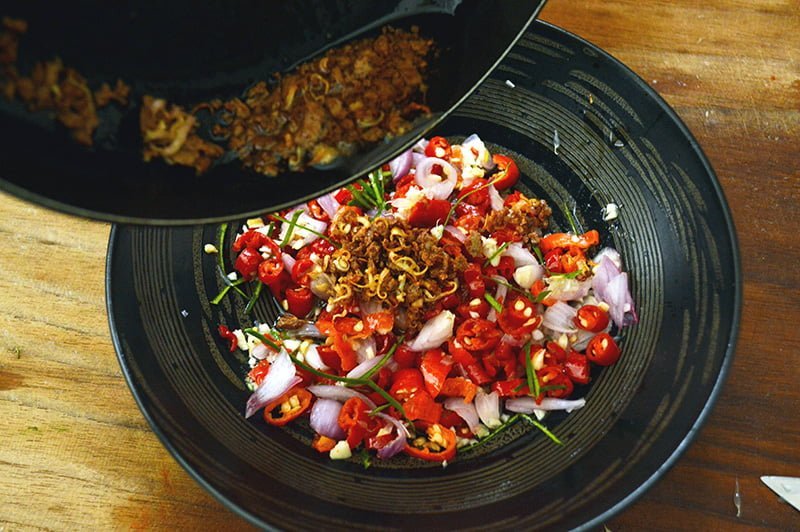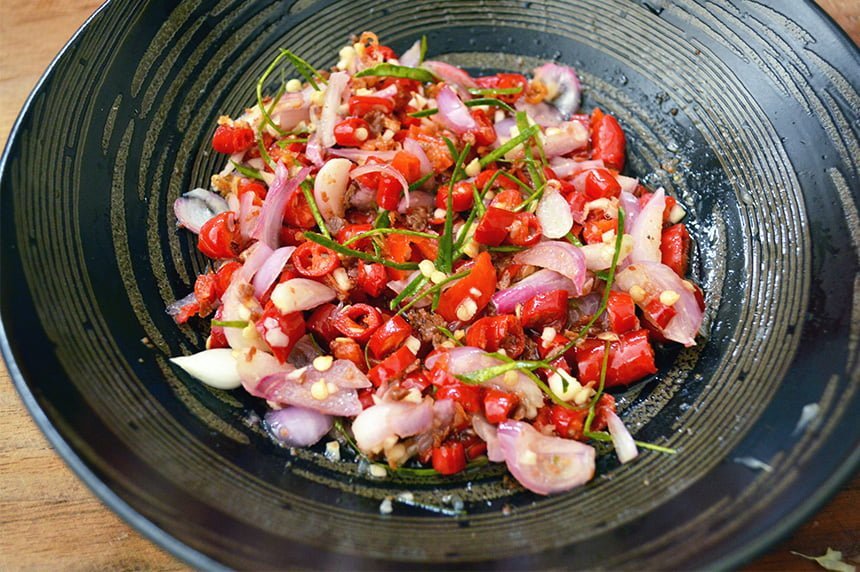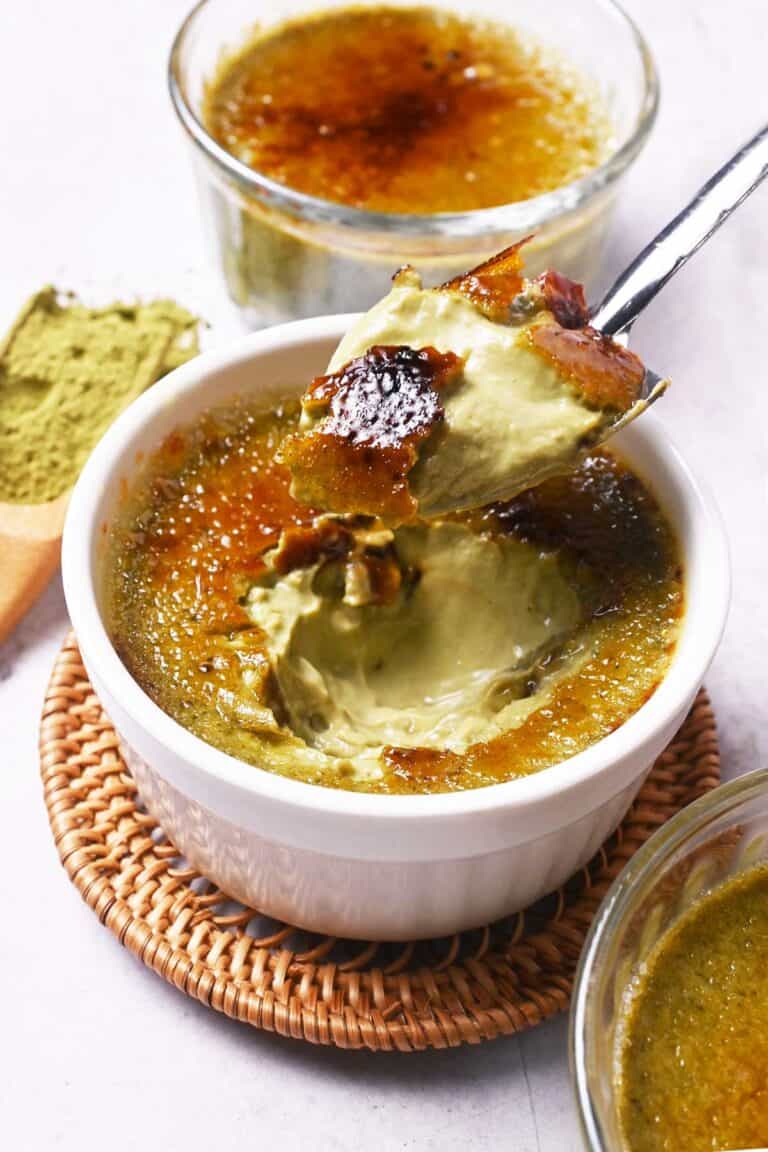Sambal Matah (Balinese Raw Sambal)
This post may contain affiliate links. Please read my disclosure policy for details.
Learn how to make Sambal Matah or Balinese Raw Sambal from scratch at home in just minutes. The condiment is perfect for almost everything from grilled seafood to fried chicken.

Sambal is essentially one thing Indonesians can not live without, including me. It is basically a condiment in chili sauce or paste form and made from a mixture of chili peppers with other seasonings and spices. The unique combination of spiciness and umami in sambal is the secret to Indonesian cuisine’s delicious reputation. There are actually hundreds of sambal varieties available throughout the archipelago and Sambal matah has been tremendously gaining popularity for the last few years. In fact, one of the biggest instant noodle producers in Indonesia released sambal matah flavored chili sauce in the form of fried noodles.
Originally from Bali, sambal matah can be translated as “raw sambal” or “raw chili sauce.” The defining characteristic of this sambal is in its spiciness and freshness. The recipe is so easy, but each bite will deliver an umami flavor bomb in a way that has me wanting to spoon the dish over and over again. All you need to do is to cut the ingredients, and then mix them with seasonings and hot oil. Simple right? You can almost eat this with everything from grilled seafood, roasted pork belly, and fried chicken. Whip up a batch and enjoy a weekly dose of this umami greatness.
Sambal Matah Ingredients
Firstly, we need an understanding of the ingredients in sambal matah to customize this particular sambal to fit your preference.


1. Chilies
We cannot call the condiment as sambal if we do not use its main ingredient, which is chili. It is not good to leave out the spicy ingredient because you will sacrifice a large amount of flavor and its authenticity.
The original sambal matah recipe actually calls for 10 bird’s eye chilies (also known as cabe rawit in Javanese). It is an elongated pepper with green-red color and tastes very spicy. I was told to mix bird’s eye chilies with some other mild chilies if you want to make the condiment tastes less spicy. For that reason, I replace 5 bird’s eye chilies with 5 red curly chilies (known as cabe keriting in Javanese) for my recipe, or you can use other cayenne peppers with moderate spiciness level.
You can also consider either removing chili pepper’s seeds, veins, and pith to reduce the spiciness. Capsaicin, the substance in chili peppers that makes your mouth perceive as hot, is concentrated there. Remove these and you will remove even more capsaicin.
2. Shallots
Shallot is in the same family as garlic and onion. However, unlike onions, which can be strong and pungent when eaten raw, shallots have a slightly sweet flavor and subtle notes of garlic. This makes shallots work especially well in dishes when eaten raw. Try doubling the number of shallots from this recipe to create less spicy and sweeter sambal matah.
3. Kaffir lime leaves
Kaffir lime leaf is probably one of the most aromatic of all herbs in many Southeast-Asian cuisines. There is no replacement for the unique flavor and fragrance the kaffir lime leaf imparts to a dish. It has thick leaves with shiny dark green on one side, and pale-colored and porous on the other side.
It can be added whole just like adding bay leaves to soups and stir-fries. In addition, it can be cut up into very thin slivers and added to spice pastes or topping for many recipes. The best way to slice kaffir lime leaves is to remove the thick center vein from the leaves. This makes the leaves easier to slice, and the tough center can be too hard to eat. Then, use a sharp knife or pair of scissors to cut the leaves into teeny slivers.
4. Lime juice
Lime is a round small green citrus fruit with an acidic and slightly bitter taste. A splash of lime juice or a pinch of finely grated zest is usually added to dishes for a refreshing and tart flavor, transforming simple dishes into real standouts. It also allows less salt to be used.
5. Garlic
Garlic is one of the most popular of herbs and spices for its delicious aroma and depth of flavor. It has a strong, spicy flavor that mellows and sweetens considerably with cooking.
6. Lemongrass
Lemongrass is widely used as a culinary herb in Asian cuisines. It has a subtle citrus-like aroma with a subtle lemony flavor. Much of lemongrass’s flavor is concentrated in its lower white inside part of the stalk. The best way to do this is by trimming off the root and essentially all of the green tops and peeling the outer green layers. The flavor is quite light, so we need to mince the white part and cook it in oil to increase its intensity.

7. Shrimp paste
Shrimp paste is a condiment made from fermented fish or shrimp and shaped like a black-brown colored dough or paste or powder. In Indonesia, we call the shrimp paste as terasi. Shrimp paste is commonly used in Southeast Asian, Indian subcontinent, and Southern Chinese cuisines. It has a sharp pungent smell and flavor-packed shrimp paste. It is used as a flavoring dish in a variety of traditional Indonesian recipes. Moreover, it is an essential ingredient in sambal.
8. Oil
Lastly, we need to add hot oil to sambal matah to semi-cook and fuse the whole flavor of the ingredients. You can use vegetable oil, but coconut oil will make it healthier and more aromatic. Oil also preserves sambal matah and improves its shelf life by providing an airtight seal for the ingredients.

Tips for Making Sambal Matah
1. Use gloves
When you use these ingredients, they can linger on your hands. Then, when you rub your eyes, even a tiny speck of the ingredient can cause pain, redness, and watery eyes. To prevent this from happening, wear gloves ,and do not rub your eyes and nose while cutting.
2. Adjust the spiciness
After learning about the ingredients we used in sambal matah, we have already learntedthe basic understanding of how to adjust its spiciness.
There are four ways to adjust the spiciness in sambal matah:
- Use whole bird eye’s chilies for extra hot spiciness level.
- Use half bird eye’s chilies and half of red curly chilies for spicy sambal.
- Substitute the chilies with cayenne peppers for moderate spiciness.
- Add more shallots for mild sambal.
3. Press down the mixture
After the hot oil is poured into cut ingredients, mix and press down the mixture a little with a wooden spoon to extract and fuse the whole flavor. While doing so, make sure to crush any shrimp paste chunks finely.
4. How to store sambal matah
After the oil has cooled down, immediately put sambal matah in a clean airtight container and keep it in the refrigerator. It will last up to 5 days in the refrigerator.
How to Serve Sambal Matah
You can use isambal matah pretty much like any other sambal, take it just a little bit for every mouthful. In Bali, sambal matah is commonly served with seafood, chicken, and roasted pork. Check out also my Crispy Dory Fillets with Sambal Matah recipe.
Nonetheless, sambal matah has been gaining popularity lately and people have experimented a lot by fusing it with other types of food like pizza, spaghetti, and noodle. You can also try spicing up your salad by adding sambal matah as the dressing.

Check Out Also These Recipes!

Ingredients
- 5 bird’s eye chilies, chopped finely
- 5 red curly chilies, chopped finely
- 6 shallots, sliced thinly
- 2 cloves garlic, minced
- 2 kaffir lime leaves, sliced thinly
- 1 tbsp lime juice
- 1/4 tsp salt
- 1/4 tsp sugar
- 1 stalk lemongrass, peel and use tender white inner bulb only, sliced thinly
- 1/2 tsp shrimp paste/terasi
- 3 tbsp coconut oil
Instructions
- In a medium bowl, combine bird’ eye chilies, red curly chilies, shallots, garlic, kaffir lime leaves, lime juice, salt, and sugar until well incorporated. Set aside.
- Heat coconut oil in a small frying pan over low heat. After the oil is heated, add shrimp paste and lemongrass until fragrant. Turn off the heat.
- Pour the hot oil mixture into the chilies mixture. Stir and press slightly to combine.
- Serve and store the leftover in an airtight container for up to one week.






